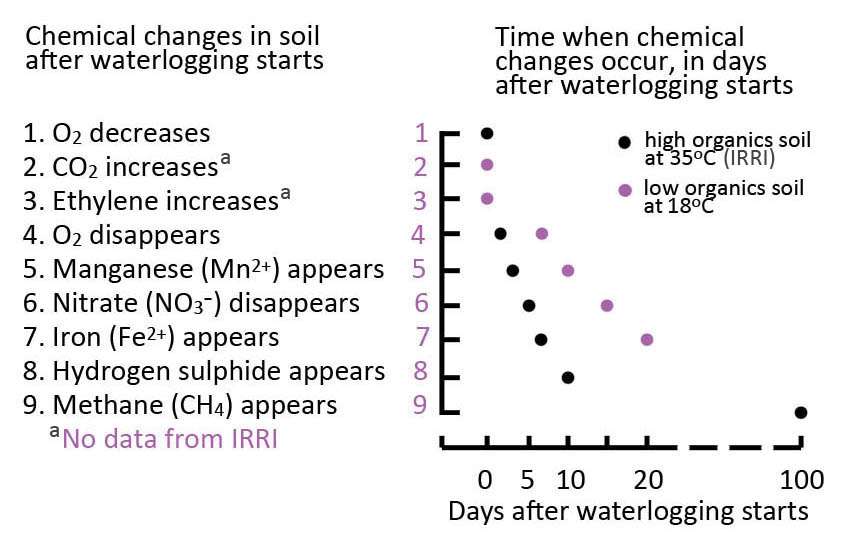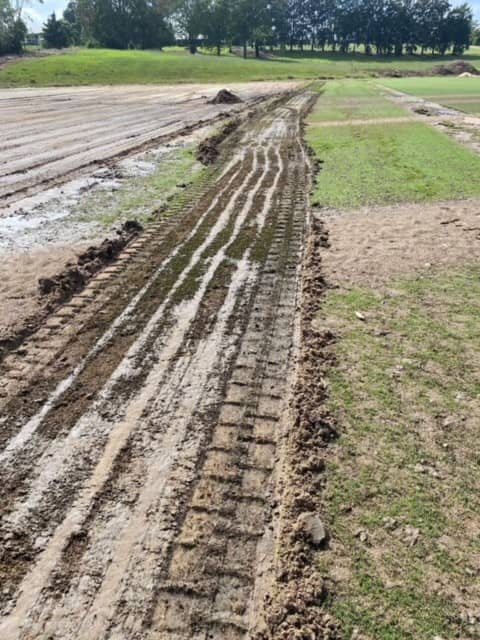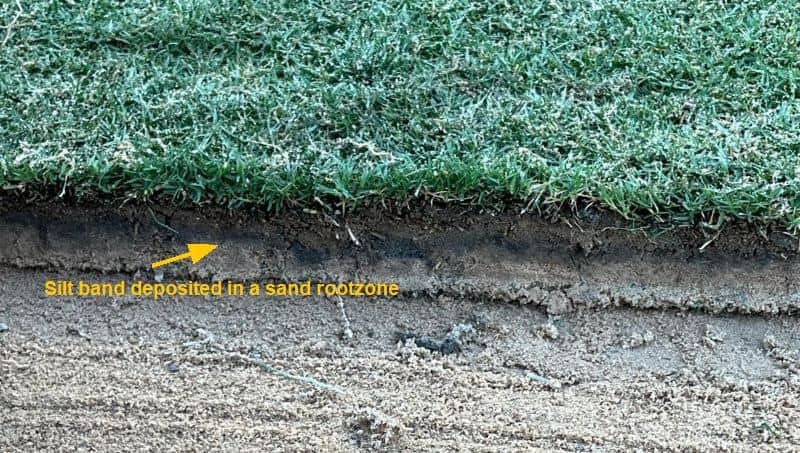How to Manage Flooded Turf?
We have put this together on how to manage flooded turf. With recent flooding having had a major impact on golf courses and sporting venues this should help you protect and get your turf back in good condition as soon as possible. The key to any recovery is planning.
Being isolated due to flooding means that taking remedial action before this occurs has a dramatic impact on recovery. Crucial to this is you need to know what happens when turf and soils flood as a lot of changes occur to the soil chemistry. The header image is courtesy of Setter and Belford (1990).
In its usual state, soil contains plenty of O₂ which enables microbial respiration and organic matter decomposition. When a soil floods, O₂ diffuses from the water into the soil surface, and forms a thin layer of oxidized soil. Underneath this is a thicker oxygen deficient layer.
Two of the by-products produced when a soil floods are the production of Methane (CH4+) and nitrous oxide (N2O).
Internal tools:
- Argentine Stem Weevil Predictor.
- Overseeding Timing Guide.
- Soil Wetting Agent Selector.
- Traffic Tolerance Calculator.
- Turf Irrigation Calculator.
- Sand amendment calculator.
Effects of Flooding on Soils.
- Both facultative and true anaerobes are active when there is an absence of oxygen.
- As a result of denitrification, nitrate is lost from the soil.
- The decomposition of organic matter slows down.
- Iron and manganese become more available, and in some cases this limits turf growth in flood prone areas.
- O₂ declines and root hairs to begin to die.
- Carbon dioxide levels in the soil increase.
- Fine soil particles contaminate the rootzone.
- Accelerated anaerobic herbicide dissipation occurs. This significantly reduces the longevity of pre-emergent herbicides as they prematurely degrade below effective concentrations.
Silt Contamination.
Silt levels in floodwater tend to contribute a substantial amount of sediment. This deposit can be from 5-10 cm depth or more depending on the flood intensity.
- Silt deposits create a physical barrier that prevents photosynthesis and leads to turf grass damage.
- Silt contains very little organic matter, has poor structure, and is prone to pugging.
Once grass is under water or the soil is saturated, soil O₂ begins to decline and turf root hairs to begin to die. Although no definitive data is available, testimonials for dormant turf indicate that most survives for longer than 4 days when it floods. This is not the case with non-dormant turf.
As the water depth of water increases, the potential for turf injury increases. The good news is that if the leaf tissue is above the water line the turf will most likely survive. However, in areas where the turf is totally under water the diagnosis isn’t so good.
Within a day of flooding, high organic matter soils:
- Become O₂ deficient.
- Photosynthesis declines.
- Respiration rates increase and
- Lateral rooting increases as a result of a lack of O₂ and sunlight.
It is worth noting that flood waters are very good at filtering out light which all plants need to photosynthesise. This is due to flood water containing high levels of dissolved organic material such as humic acids and particulate material such as silt.
Water temperature.
Grass does not survive for long at water temperatures above 16°C. Research shows that at cooler water temperatures of 10°C or less, turfgrass is able to withstand being submerged for up to 60 days. In contrast, at water temperatures of 30°C or higher, it dies within 24 hours .
There are several options to consider to prepare for flooding, and give your turf areas a better chance of recovering.
Being aware of how floods and heavy rainfall affect herbicide performance also effects what turf products to use in flood prone areas.
How to manage flooded turf – Preparation.
Here are a few tricks to adopt to try and increase the chances of turf survival. The key is doing these before floods as afterwards it is too late.
- Apply trinexapac-ethyl (Amigo® 120) at a high label rate prior to flooding. This slows turf growth, respiration and leaf etiolation.
- Diseases such as pythium root rot on cool season turf and ERI fungi on warm-season turf thrive in waterlogged soils. After flooding you will not be able to spray or water in any fungicide as soils are saturated.It’s far easier to make preventative applications.
Grenadier fungicide ® (fosetyl aluminum) or AzoForce fungicide® (azoxystrobin) are good options, as they give you around 21 days of protection.
Turf Selection.
This makes a huge difference to the chances of turf survival. For example, creeping bentgrass is more tolerant of floods than either tall fescue or Kentucky bluegrass. Winter grass, red fescue, Kentucky bluegrass and perennial ryegrass are the least flood tolerant.
For warm season C4 grasses, the best performer is seashore paspalum. Next are couch and zoysia with buffalo grass varieties falling in the middle.
- Couch can still survive after 55 days of flooding.
- In certain situations tall fescue and Kentucky bluegrass still survive after 35 days. In fact, kentucky bluegrass rhizomes can survive flood events and contribute to 50% of field recovery.
How to Manage Fooded turf – The Aftermath.
- Remove all the rubbish and sediment off the surface after a flood event. Not only is this important from a safety perspective it also helps get sunlight to the turf canopy.
- Be aware that any traffic over the surface at this stage is highly likely to damage the soil structure and create future issues.
- Allow flooded areas to dry before mowing. This reduces the risk of damaging wet, muddy areas with mowers.
- At this stage the weakened stressed turf is highly vulnerable to pest and disease activity.
Management.
As soon as waters recede aim to apply nitrogen as this can dramatically reduce the impact of waterlogging. The correct timing of nitrogen application on waterlogged crops can also significantly increase the speed of recovery.
Application of an ammonium-containing turf fertiliser (urea, or ammonium sulphate) or manure shortly before a wet period, suffers minimal losses. This is because saturated soils don’t undergo nitrification until the soil dries and it becomes aerobic.
Use of granular or liquid nitrogen. Liquid fertilisers supply nitrogen directly to the leaves to replace nitrogen normally supplied from the soil, and so apply at any time.
Granular fertilisers are more effective if applied immediately after waterlogging has gone.
Other Options.
As turf managers there is a lot to learn from the horticulture and agriculture industries in relation to flood management. All of the options below have been shown to reduce damage. This doesn’t mean that they will stop it but in certain situations they will help with recovery.
- Foliar and root applications of the biostimulant salicylic acid improve phostosynthetic efficiency. Salicylic acid has shown to be effective in reducing waterlogging stress and this has been shown in a range of crops such as tomatoes. See this turf pigment presentation for more information.
- Use the amino acids glycine, serine and alanine to enable plants to cope with oxygen starvation. Use of products with high levels of these amino acids prior to floods makes a lot of sense. Different products contain varying amounts of these amino acids so use products that show their specific amino acid contents.
- Apply ethephon. This reduces waterlogging stress. The etoliated growth that occurs in submerged turf occurs because of a build up of ethylene. When flood waters recede leaf etoliation means that turf is less fit for photosynthesis. If you apply ethephon it increases the chances of turf to be “match ready” to photosynthesise as soon as possible.
Conclusion.
Flooding is awful at the best of times from both a physical and mental perspective. Hopefully the suggestions above can help reduce stress on you and your turf and help you get your playing surfaces back as soon as possible.
©, 2022, Gilba Solutions, All rights reserved.

Jerry Spencer
Jerry has an Hons Degree in Soil Science (1988) from Newcastle Upon Tyne University. He then worked as a turf agronomist for the Sports Turf Research Institute (STRI) until 1993.
He gained a Grad Dip in Business Management from UTS in 1999. He has held a number of technical roles for companies such as Arthur Yates (Commercial Technical Manager) and Paton Fertilizers (Organic, turf specialty and controlled release fertiliser) portfolios.
In 2013 he established Gilba Solutions as independent sports turf consultants and turf agronomists. Jerry has written over 100 articles and two books on a wide range of topics such as Turf Pesticides and turfgrass Nutrition which have been published in Australia and overseas.



